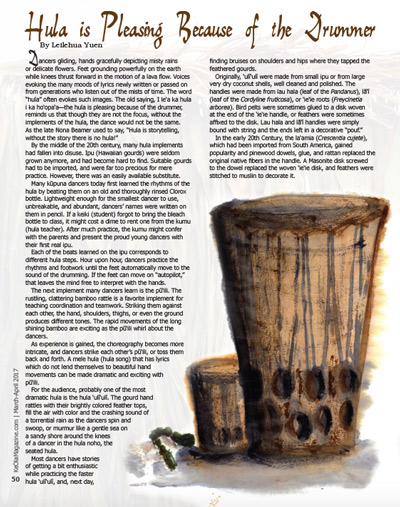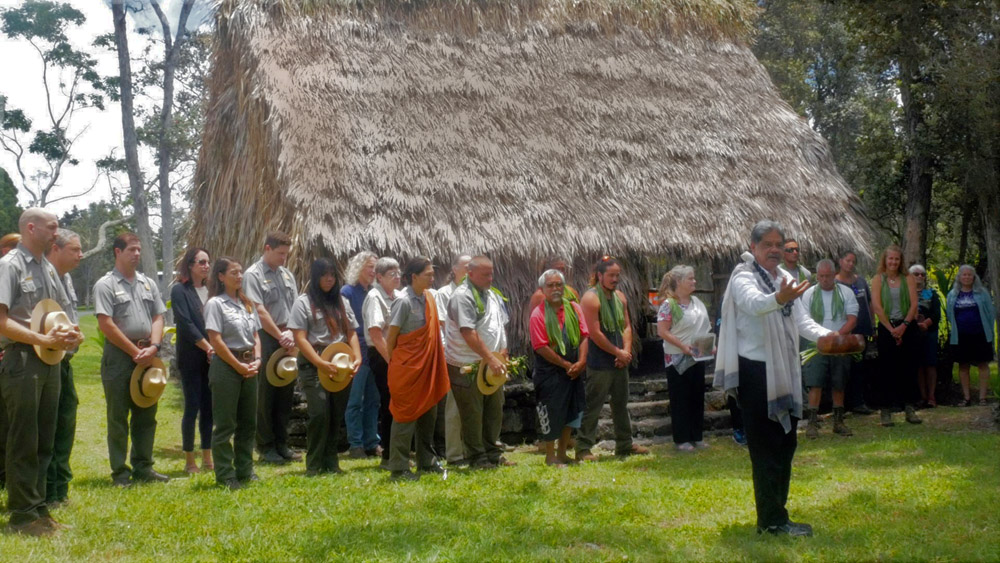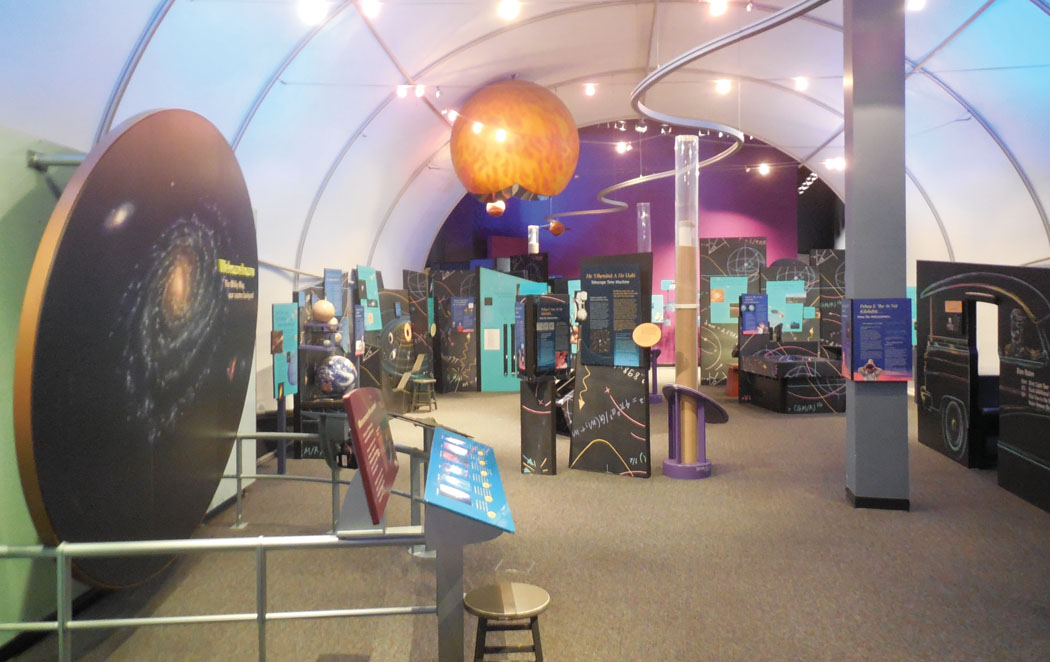
Hula is Pleasing Because of the Drummer
By Leilehua Yuen
 Dancers gliding, hands gracefully depicting misty rains or delicate flowers. Feet grounding powerfully on the earth while knees thrust forward in the motion of a lava flow. Voices evoking the many moods of lyrics newly written or passed on from generations who listen out of the mists of time. The word “hula” often evokes such images. The old saying, I le‘a ka hula i ka ho‘opa‘a—the hula is pleasing because of the drummer, reminds us that though they are not the focus, without the implements of the hula, the dance would not be the same. As the late Nona Beamer used to say, “Hula is storytelling, without the story there is no hula!”
Dancers gliding, hands gracefully depicting misty rains or delicate flowers. Feet grounding powerfully on the earth while knees thrust forward in the motion of a lava flow. Voices evoking the many moods of lyrics newly written or passed on from generations who listen out of the mists of time. The word “hula” often evokes such images. The old saying, I le‘a ka hula i ka ho‘opa‘a—the hula is pleasing because of the drummer, reminds us that though they are not the focus, without the implements of the hula, the dance would not be the same. As the late Nona Beamer used to say, “Hula is storytelling, without the story there is no hula!”
By the middle of the 20th century, many hula implements had fallen into disuse. Ipu (Hawaiian gourds) were seldom grown anymore, and had become hard to find. Suitable gourds had to be imported, and were far too precious for mere practice. However, there was an easily available substitute.
Many kūpuna dancers today first learned the rhythms of the hula by beating them on an old and thoroughly rinsed Clorox bottle. Lightweight enough for the smallest dancer to use, unbreakable, and abundant, dancers’ names were written on them in pencil. If a keiki (student) forgot to bring the bleach bottle to class, it might cost a dime to rent one from the kumu (hula teacher). After much practice, the kumu might confer with the parents and present the proud young dancers with their first real ipu.

on page 50.
Each of the beats learned on the ipu corresponds to different hula steps. Hour upon hour, dancers practice the rhythms and footwork until the feet automatically move to the sound of the drumming. If the feet can move on “autopilot,” that leaves the mind free to interpret with the hands.
The next implement many dancers learn is the pū‘ili. The rustling, clattering bamboo rattle is a favorite implement for teaching coordination and teamwork. Striking them against each other, the hand, shoulders, thighs, or even the ground produces different tones. The rapid movements of the long shining bamboo are exciting as the pū‘ili whirl about the dancers.
As experience is gained, the choreography becomes more intricate, and dancers strike each other’s pū‘ili, or toss them back and forth. A mele hula (hula song) that has lyrics which do not lend themselves to beautiful hand movements can be made dramatic and exciting with pū‘ili.
For the audience, probably one of the most dramatic hula is the hula ‘ulī‘ulī. The gourd hand rattles with their brightly colored feather tops, fill the air with color and the crashing sound of a torrential rain as the dancers spin and swoop, or murmur like a gentle sea on a sandy shore around the knees of a dancer in the hula noho, the seated hula.
Most dancers have stories of getting a bit enthusiastic while practicing the faster hula ‘ulī‘ulī, and, next day, finding bruises on shoulders and hips where they tapped the feathered gourds.
Originally, ‘ulī‘ulī were made from small ipu or from large very dry coconut shells, well cleaned and polished. The handles were made from lau hala (leaf of the Pandanus), lā‘ī (leaf of the Cordyline fruticosa), or ‘ie‘ie roots (Freycinetia arborea). Bird pelts were sometimes glued to a disk woven at the end of the ‘ie‘ie handle, or feathers were sometimes affixed to the disk. Lau hala and lā‘ī handles were simply bound with string and the ends left in a decorative “pouf.”
In the early 20th Century, the la‘amia (Crescentia cujete), which had been imported from South America, gained popularity and pinewood dowels, glue, and rattan replaced the original native fibers in the handle. A Masonite disk screwed to the dowel replaced the woven ‘ie‘ie disk, and feathers were stitched to muslin to decorate it.
In ancient times, both the pū‘ili and the ‘ulī‘ulī were used singly, and around the turn of the previous century, when hula shows became popular tourist fare, the visual drama of the paired implements became de rigueur. At hula competitions today, the same hālau may dance with one implement in the Kahiko division, and with two in the ‘auana.
Some hālau require dancers to make their own implements, and may take harvesting expeditions to farms, forests, and sea to collect the materials. One favorite expedition is for ‘ili‘ili, after all, who would not want to spend a day at the beach.
Often, the hālau will go to a beach renowned in song. For older Moku o Hawai‘i (Hawai‘i Island) dancers and their kūpuna, Kaimū in Puna was a popular place to go and learn “‘Auhea o Kalani,” a mele hula for King Lunalilo which celebrates his surfing skill. It is set at that now-lava-covered beach.
Learning the mele there, in the shade of the very coconut trees which shaded the King, visiting the park where the freshwater Wai‘ākōlea pond lay dappled in the sun and shade, imagining how the King himself had bathed there after surfing at Kaimū, all these things made gathering the ‘ili‘ili from that place so very special. Those memories, stimulated each time the ‘ili‘ili were picked up to dance, added their mana, their spiritual energy, to the hula.
Though the black sands of Kaimū now lie buried, the tradition of visiting such wahi pana (celebrated places) continues and remains part of the teaching of hula.
| ‘Auhea o ka lani lā, aia i ka he‘e nalu He‘e ana i ka lala lā, ho‘i ana i ka muku A ka nalu o Hō‘eu lā, ‘eu ho‘i a‘e kāua A pae a‘e Kaimū lā, ho‘omū nā kānaka ‘Au‘ai i ka wai lā, a‘o Wai‘ākōlea Lu‘u aku a aea mai lā, Kānaenae o ka Lani Ha‘ina mai ka puana lā, No Lunalilo ō he inoa |
Where is the royal chief? There surfing Surfing on the long wave, returning on the short wave On the Hō‘eu wave we both return And land at the sea of Kaimū where the natives gather We bathe in the fresh water, the pond of Wai‘ākōlea We dive and surface, a prayerful chant for the King Tell the refrain, in the name of Lunalilo |
Slightly larger stones also are used in the hula. As taught by Aunty Nona Beamer in the hula “He Motu ta Ura,” a flat round stone, the Pōhaku Hina, is held in the left hand and a longer cylindrical Pōhaku Kū is held vertically in the right. The Pōhaku Kū is tapped on the Pōhaku Hina in time with the hula. Aunty Nona taught this hula as a gentle poem of the sunset, and the choreography and implements reflect a peaceful evening at the seashore.
In other choreography, this same hula is often danced using long and short kāla‘au (rhythm sticks), or even an ‘ihe (javelin), and pāhoa (dagger). Chief Kalani‘ōpu‘u-a-Kaiamamao of Kona was not only a famed warrior; he was also a great aficionado of the hula. He used a version of “He Motu ta Ura” as a victory chant when he killed two chiefs from Maui. (Kalani‘ōpu‘u is the same chief who, in his later years, greeted Capt. James Cook at Kealakekua.) This choreography honors his use of the mele.
A kāla‘au or ‘ihe about the height of the dancer is held in the left hand, and a shorter kāla‘au or a pāhoa is held in the right. By grasping the sticks harder or softer, and in different positions along their length, the tone can be changed to suit the melody and rhythm of the hula.
In a third variant used on Kaua‘i, the dancers use the ‘ūlili, the spinning gourd rattles. Comprising three gourds on a stick, this rattle is manipulated with a string wound around the stick inside of the center gourd. The center gourd is held in one hand, and the string pulled through a hole in one side. This spins the rattle and the two end gourds, making a whirring and clattering sound. Many of the hula and implements of Kaua‘i are unique to that island, and only recently have been used in other parts of Hawai‘i Nei.
Hula is an evolving art form which has its roots in the dance traditions brought by the earliest settlers. Various scholars date this at times ranging from the beginning of the Common Era to around 600CE. They brought with them their musical traditions, stories, and dances. They probably changed gradually over the generations, with occasional innovations, until the arrival of La‘amaikahiki during what some believe to be the height of the 12th to 14th Century migrations.
La‘amaikahiki made major changes, and brought the great pahu (drum) used in worship within the heiau, and presumably the ha‘a (bent knee dancing) was danced in the sacred confines of the temple.
Centuries later, in the time of Kalani‘ōpu‘u, and then Liholiho, sacred son and heir of Pai‘ea Kamehameha, the great drum was brought outside the heiau and began to see use for hula. Shortly after that, new instruments from the other side of the world, brought by sailors, traders, merchants, and missionaries began to find a place in the music of Hawai‘i Nei. The Spanish who came to help Hawaiians learn to work cattle made their mark, adding guitar melody and dance steps from their homeland to the mele and hula of the islands.
Long before European contact, the Hawaiian people found that the innovations in singing brought by the religious music of the American missionaries added new melodies and texture to the vocal accompaniment of the hula.
Even native implements changed. Documentation of the ipu heke, the chanter’s double gourd drum, abounds from the earliest records, before the early 20th Century there is a paucity of information on the dancers’ small gourd hula drum. It is often found used in dances such as “Green Rose Hula,” and may be an early 20th Century innovation.
From ancient times, Hawaiian people were familiar with the potential of stringed instruments, and used the ‘ūkēkē, a sort of stringed jaw harp. After western instruments such as the guitar, ‘ukulele, bass, and fiddle were adopted, the late 19th through the 20th centuries were times of major evolution in Hawaiian music. Sam Li‘a with his fiddle, the Pahinui family in guitar, Helen Desha Beamer and the piano, plus so many more contributed to the diverse tradition we are heir to today.
Hawaiian musicians and dancers of the 21st Century continue that heritage of evolution, continuing to honor the past while creating new works for the future. What new instruments will be added? What new rhythms will they play? What new steps will accompany them? What new stories will they tell?
Contact writer/artist Leilehua Yuen: kumuleimanu@gmail.com


